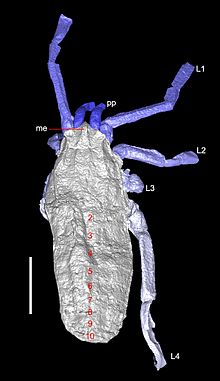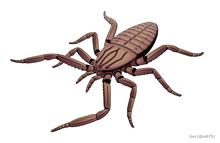 Global Information
Global InformationPlesiosiro information
| Plesiosiro Temporal range:
| |
|---|---|

| |
| CT scan | |

| |
| Life restoration | |
| Scientific classification | |
| Domain: | Eukaryota |
| Kingdom: | Animalia |
| Phylum: | Arthropoda |
| Subphylum: | Chelicerata |
| Class: | Arachnida |
| Clade: | Tetrapulmonata |
| Order: | †Haptopoda Pocock, 1911 |
| Genus: | †Plesiosiro Pocock, 1911 |
| Species: | †P. madeleyi
|
| Binomial name | |
| †Plesiosiro madeleyi Pocock, 1911
| |
Plesiosiro is an extinct arachnid genus known exclusively from nine specimens from the Upper Carboniferous of Coseley, Staffordshire, United Kingdom.[1][2] The genus is monotypic, represented only by the species Plesiosiro madeleyi described by Reginald Innes Pocock in his important 1911 monograph on British Carboniferous arachnids. It is the only known member of the order Haptopoda.[3]
The original fossils have been redescribed in detail by Alexander Petrunkevitch in 1949[4] and Dunlop in 1999.[2] A supposed example from the Coal Measures of Lancashire is a misidentification.[2]
- ^ Garwood, Russell J.; Dunlop, Jason (2014). "Three-dimensional reconstruction and the phylogeny of extinct chelicerate orders". PeerJ. 2: e641. doi:10.7717/peerj.641. ISSN 2167-8359. PMC 4232842. PMID 25405073.
- ^ a b c Dunlop, Jason A. (2011). "A redescription of the Carboniferous arachnid Plesiosiro madeleyi Pocock, 1911 (Arachnida: Haptopoda)". Transactions of the Royal Society of Edinburgh: Earth Sciences. 90 (1): 29–47. doi:10.1017/S0263593300002492. ISSN 0263-5933.
- ^ Reginald Innes Pocock (1911). A Monograph of the Terrestrial Carboniferous Arachnida of Great Britain. Monographs of the Palaeontographical Society, London. pp. 1–84.
- ^ Alexander Petrunkevitch (1949). "A study of Palaeozoic Arachnida". Transactions of the Connecticut Academy of Arts and Sciences. 37: 69–315.